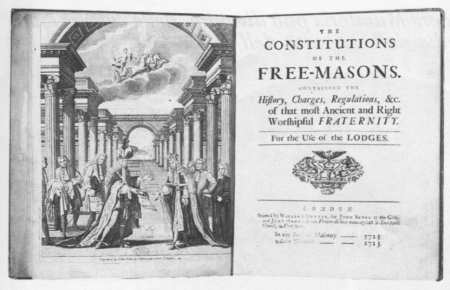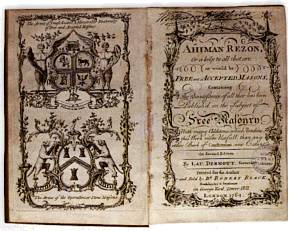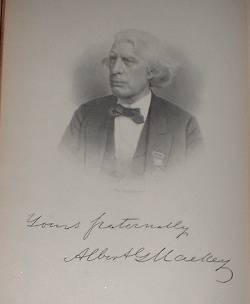|
The term "Landmarks"
is known to all brethren, yet its' definition is not always as clear. Moreover,
these Landmarks are often connected to the Old Charges. My aim here is to
clarify these terms and draw distinct lines between three terms.
1. 'Old Charges' is the name
given to certain manuscripts having more or less the same
contents. It is a term which is used to
characterize 131 manuscripts, the oldest of
which is "Regius" dated 1390. These
manuscripts contain 'Charges' in the sense of
rules which all Masons are obliged to keep. Most
of these Charges are concerned
with the operative building craft and with its'
regulation. The York legend is part of
these manuscripts.
2. Antient Charges &
Regulations have nothing to do with the Old Charges. They are a
set of 15 regulations which appear in the first
pages of the Book of Constitutions of
the UGLE. Though they are said to be
"Summary of the…" they are the only ones.
They are not a summary of any other set. Every
Master-Elect has to promise to keep
them before he is obligated as WM.
3. Landmarks are basic
principles of Freemasonry similar to axioms in mathematics.
Basically they are boundary lines or marks
between what is inside the boundaries of
Freemasonry and what is outside of them.

It should be stressed that
boundary lines, or border marks, have in all ages been regarded by men as most
important and zealously kept. In the Bible they are regarded as sacred. In
Deuteronomy 27,17 we find: "Cursed be he that removeth his neighbor's
landmark". Similar references can be found in Proverbs 22,28 and in Job
24,2. We should remember that such boundaries always imply that all recognizes
them as such.
In Masonic literature, there
are many efforts to deal with the Landmarks of our Craft and it is generally
agreed that the definition of what is a Landmark is not easy. In order to better
understand the difficulties let us use some examples:
It is obligatory that every
Brother believes in the Great Architect of the Universe and that there must be
an open VSL on the Altar when a lodge is at work. These are two of our
Landmarks. They are not included in the Old Charges or in the Antient Charges
and Regulations. On the other hand, Recognizing "only three degrees of EA,
FC and MM and the Installation ceremony of a WM" is not a Landmark but part
of the Antient Charges and Regulations.
According to William Preston,
Landmarks are boundaries set up in order to check all innovations. This is
expressed well in the 11th Regulation, namely:
"You admit that it is not
in the power of any Man or Body of Men to make
innovations in the body of
Masonry"
John S. Simons defined
Landmarks[1] in a comprehensive way as
follows:
"We assume those
principles of action to be landmarks which have existed from
time immemorial, whether in
the written or unwritten law: which are identified
with the form and essence of
the society: which the great majority agree, cannot
be changed, and which every
mason is bound to maintain intact under the most
solemn and inviolable
sanctions".
It is quite clear that this
definition includes three necessary elements which define a Landmark as such:
1. It exists from time
immemorial,
2. It expresses the form and
essence of the Craft,
3. It is agreed that it can
never be changed.
More often than not, when
Landmarks are discussed, only two of these elements are mentioned, namely that
they are 'from time immemorial' (ancient) and that they cannot be changed. Very
often, any attempt to change even a trifle is met with criticism that it is
against our Landmarks. In my view, the most important element is that a Landmark
must express the form and essence of the Masonic body. Furthermore, the weakest
element in this definition is the third part: what does it mean "agreed
that it can never be changed"? Agreed by whom? When? And, if it will be
agreed to change a Landmark, will it stop to express the essence of Freemasonry?
It is almost like saying: a Landmark is a Landmark because we say so. Is this a
definition? It seems to be generally accepted that not only did Landmarks set
borders, but that they were recognized as such; they were considered as
legitimate. One should realize, that in such a case if there is a general
consent of all concerned, these borders may be changed. Indeed, the original
phrasing of this clause included: "…without the consent first obtained of
…Grand Lodge". This final part was omitted after the UGLE was formed[2]. This was a significant
change from an adjustable set of Landmarks to a full and final canonization.
In his book "Speculative
Masonry" [3], A.S. Macbride defined our
Landmarks as "certain established usages and customs, occupying the
position which usage and custom do in a community" namely, similar to
'common law' in a political system. These Landmarks are similar to civil laws
but they differ in one respect: they were adopted by a Grand Lodge. At the same
time, it should be pointed out that not every usage or custom is a Landmark;
There must exist an additional condition: it has to serve as a border between
what is within the boundaries of the Craft and what is outside these boundaries.
Only such usages can become Landmarks. In other words: the Landmarks of
Freemasonry are established usages and customs which serve as boundaries both
inwards as well as outwards of a Masonic organization If we examine this
definition closely, it will be apparent that it contains a goal; not only
boundaries but such that conform to the goals of Speculative Freemasonry.
It seems to me that the need
to set Landmarks supports the 'Transition Theory' at least partly. When
operative lodges started to accept non-operative Masons, and the building of a
spiritual and moral temple became the central target, there arose the need to
set agreed-upon boundaries. In other words: only Landmarks which serve the goals
of speculative Masons were chosen from among the usages and customs already
existing in the (operative) lodges. Just as the need of a lodge for the
builders, before actual building was started, so do we need a set of rules
before a human temple is erected for the building of a spiritual temple; for
shaping the human rough ashlars in accordance with moral principles.

According to Macbride, the
Landmarks listed in Dermot's 'Ahiman Rezon' (1756) about a hundred years before
Mackey's Encyclopaedia was published, include several which do not conform with
the typical goals of Landmarks as defined by Simons above. So did others in
their lists of Landmarks, some of which were new inventions and not existing
usages and customs.
When we examine the
twenty-five Landmarks of Mackey, it becomes clear, which Landmarks express the
quintessence of Freemasonry and which express structural aspects only. If we
accept Simons's definition of Landmarks, it is quite obvious that those
Landmarks which deal only with Grand Master and Grand Lodge cannot be "from
time immemorial". After all, these could not exist before 1717.
Furthermore, they have nothing to do with 'a system of Morality'. The same
applies to any Landmark concerning the third degree. Although the Hiramic legend
is very old, the tri-gradal system was created only around 1730.
As B.E. Jones rightly pointed
out in his "Freemason's Guide & Compendium"[4], although every Freemason has
to observe the Landmarks, there is no authoritative definition of what is a
Landmark, nor are they named in many Grand Lodge Constitutions. Masonic writers
often quote Mackey's list of 25 Landmarks, which are fully listed by Jones.
When we examine Mackey's
Landmarks, we can discern between four groups:
a. Those concerning the
fraternity and the essence of the Craft: §§. 1-3, 9, 11, 18-24
b. Those concerning the Grand
Master and his rights: §§. 4-8
c. Those concerning the rights
of a Brother: §§. 12-15, 17
d. Those concerning the duties
of a lodge, including inter-relations between lodges:§§. 10, 16.
In my opinion, the last
Landmark can hardly be regarded as a Landmark at all, since all it stipulates is
that these Landmarks can never be changed. Certainly not when we know the self
same Landmark was changed in 1823.

All Landmarks concerning the
Grand Master and Grand Lodge are obviously not 'from time immemorial' and have
nothing to do with Freemasonry being 'a peculiar system of Morality'. The same
goes to the last group above, since 'Private Lodges' existed well after 1717, so
they too are not ancient.
Roscoe Pound listed only seven
Landmarks, which in my opinion fully conform to Simons's definition of
Landmarks. These are:
1. Belief in TGAOTU.
2. Belief in resurrection and
life hereafter.
3. Obligation to have an open
VSL in lodge when at work.
4. The legend of the third
degree.
5. Obligatory secrecy. (Modes
of Recognition)
6. The foundation of our
speculative art and its' symbolic use for the purposes of
religious and moral teaching.
7. A candidate must be male,
free of birth and of age.
No doubt, this concise list of
Landmarks better relates to the absolute necessary boundaries of our Craft.
Being a jurist by profession, Pound included as Landmarks only those which truly
express the quintessence of Masonry and excluded those which are administrative
in nature.
The 24th Landmark in Mackey's list is almost identical with Pound's
6th Landmark, which is the connection between the operative Craft and our
Speculative Freemasonry. One should note, that it does not make Speculative
Freemasonry a direct descendent of operative Masonry; it only stipulates a
connection between the two, adding a definite purpose to our moral speculations.
There are several lists of Landmarks, the shortest containing only 7 (Pound's)
and the largest nearly a hundred. The most well known is that of Mackey,
containing 25 Landmarks.
It is my hope that I have
helped to better understanding of the meaning of our Landmarks.
| MACKEY'S LANDMARKS |
|---|
|
1)The modes of
recognition.
2) The division of Symbolic Masonry into three degrees.
3) The Legend of the Third Degree.
4) The government of the fraternity by a presiding officer
called a Grand Master.
5) The prerogative of the Grand Master to preside over
every assembly of the craft.
6) The prerogative of the Grand Master to grant
Dispensations for conferring degrees at irregular times.
7) The prerogative of the Grand Master to give
dispensations for opening and holding Lodges.
8) The prerogative of the Grand Master to make masons at
sight.
9) The necessity of masons to congregate in lodges.
10) The government of the craft, when so congregated in a
Lodge by a Master and two Wardens.
11) The necessity that every lodge, when congregated,
should be duly tiled.
12) The right of every mason to be represented in all
general meetings of the craft and to instruct his representatives.
13) The Right of every mason to appeal from the decision of
his brethren in Lodge convened, to the Grand Lodge or General
Assembly of Masons.
14) The right of every mason to visit and sit in every
regular Lodge.
15) No visitor, unknown as a mason, can enter a Lodge
without first passing an examination according to ancient usage.
16) No Lodge can interfere in the business of another Lodge,
nor give degrees to brethren who are members of other Lodges.
17) Every freemason is amenable to the Laws and Regulations
of the masonic jurisdiction in which he resides.
18) Qualifications of a candidate: that he shall be a man,
unmultilated, free born, and of mature age.
19) A belief in the existence of God.
20) Subsidiary to this belief in God, is the belief in a
resurrection to a future life.
21) A "Book of the Law" shall constitute an indispensable
part of the furniture of every Lodge.
22) The equality of all masons.
23) The secrecy of the institution.
24) The foundation of a Speculative Science, for purposes
of religious or moral teaching.
25) These Landmarks can never be changed. |
NOTE
[1] J. W. Simons, The Principles of Masonic
Jurisprudence"
[2] T. O Haunch, Prestonian Lecture for 1972, which was a
study in change.
[3] Published by Southern Publishers Inc, Masonic
Publications Division, 1924.
| ![]() News Feed |
News Feed |  Subscribe News by Email
Subscribe News by Email